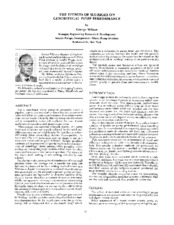| dc.description.abstract | For a centrifugal slurry pump to accurately match a pipeline system, it is necessary to know how the presence of solids will affect the pump performance. If accurate corrections are not made, it is likely that the pump and the system will be mismatched, which will accelerate the rate of wear ad increase operating and maintenance costs. When pumps are required to handle slurries, the pump head and efficiency are mainly affected by the solid size, solid concentration and solid density. Settling slurries behave differently from non-settling slurries. Consequently, the head and efficiency reductions and the shape of the performance curves will be quite different. Simple, graphical methods will be presented for predicting how the characteristics of centrifugal slurry pumps, when pumping either settling or non-settling type slurries differ from the clear water performance of the pump in question. The nature of the slurry itself, settling or non-settling, will also be considered. For slurries with a narrow band distribution of very small particles where the average size is usually less than 100 microns, the slurry will be “non-settling” and will beave as a Newtonian liquid. Consequently, standard viscosity correction procedures can be adopted to predict pump performance, provided the “apparent” or dynamic viscosity of the slurry is known. Based on a number of tests on fine mesh solids, an apparent viscosity-concentration relationship curve is presented, which when used in conjunction with the Hydraulic Institute chart for viscous liquids, will facilitate the plotting of the pump slurry characteristics curves (head, capacity, efficiency and BHP). Usually slurries with a distribution of larger particles will be “Settling” and the particles and the liquid will exhibit their own characteristics. As the liquid passes over the particles, energy will be dissipated due to the liquid “drag” which results in a reduction in pump head efficiency. The reduction in velocity between the liquid and the particle indicates that the pump performance can be related to the terminal free fall or “settling” velocity of the particles in the liquid. The particle shape and hindered effects are ignored herein. Nevertheless, a reasonable prediction of head and efficiency reduction ratios are derived for “settling” slurries where water is the conveying medium. These reduction ratios are derived from composite curves based on actual test data reduction and relate the average soil solids particle size and specific gravity to particle drag and concentration coefficients. | en |


